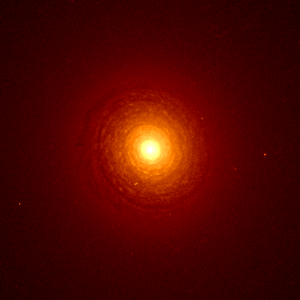NGC 759
| Galaxy NGC 759 |
|
|---|---|

|
|
| Photo from the Hubble Space Telescope | |
| AladinLite | |
| Constellation | Andromeda |
|
Position equinox : J2000.0 , epoch : J2000.0 |
|
| Right ascension | 01 h 57 m 50.3 s |
| declination | + 36 ° 20 ′ 35 ″ |
| Appearance | |
| Morphological type | E. |
| Brightness (visual) | 12.8 mag |
| Brightness (B-band) | 13.8 mag |
| Angular expansion | 1.4 '× 1.4' |
| Surface brightness | 13.6 mag / arcmin² |
| Physical data | |
| Affiliation | Abell 262 LGG 37 |
| Redshift | 0.015567 ± 0.000047 |
| Radial velocity | 4667 ± 14 km / s |
|
Stroke distance v rad / H 0 |
(215 ± 15) · 10 6 ly (65.8 ± 4.6) Mpc |
| history | |
| discovery | Heinrich Louis d'Arrest |
| Discovery date | 17th September 1865 |
| Catalog names | |
| NGC 759 • UGC 1440 • PGC 7397 • CGCG 522-087 • MCG + 06-05-067 • IRAS 01548 + 3605 • 2MASX J01575032 + 3620351 • NVSS J015750 + 362037 • LDCE 115 NED037 | |
NGC 759 is an elliptical galaxy from the Hubble type E0 in the constellation Andromeda the northern sky . In addition to a spiral structure, which appears almost in plan view, the galaxy has a 40 ° inclined ring of ionized gas with a diameter of 1 kpc . It is an estimated 215 million light years away from the Milky Way and about 85,000 light years across. The galaxy is considered a member of the Abell 262 galaxy group .
In the same area of the sky are u. a. the galaxies NGC 717 , NGC 732 , NGC 753 , IC 178 .
The Type Ia / Pec supernova SN 2002fb was observed here.
The object was discovered on September 17, 1865 by Heinrich Louis d'Arrest .
Web links
Commons : NGC 759 - collection of images, videos, and audio files
